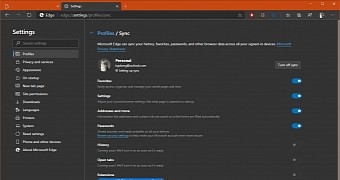The migration to Chromium allowed Microsoft to bring the Edge browser to macOS as well, and rumor has it that a Linux version is already in the works at the time of writing.
And given Edge is also available on Windows 7, Windows 8.1, Android, and iOS, Microsoft’s browser has become a truly cross-platform application, just like the likes of Google Chrome and Mozilla Firefox.
Expanding Edge beyond the world of Windows also makes it possible for the Redmond-based software giant to offer new capabilities including synchronization that allows users to have their data migrated from one device to another automatically. Furthermore, Edge can now enable users to start browsing on one device and then continue from where they left off on another, technically allowing for a seamless browsing session even when switching devices.
Microsoft itself is betting big on sync support, and this is one of the reasons the company is already planning some pretty significant updates in Microsoft Edge on the desktop (similar capabilities will also be added to mobile, if possible).
At this point, Microsoft Edge offers sync for five different categories of data, as it follows:
- Favorites
- Settings
- Addresses and contact info
- Passwords
- Collections
All these settings can be found at the following location in Microsoft Edge:
Microsoft Edge > Settings > Profiles > Sync
However, Microsoft is now working on several new sync options that will soon make their way to the stable version of Edge. The Canary build, which receives updates on a daily basis, now includes additional information on the items that Edge will be able to sync in the coming future, such as the following:
- History
- Open tabs
- Extensions
While these options already appear in Microsoft Edge Canary, the toggle is disabled, and Microsoft says they are coming soon. “We’ll turn it on as soon as it’s ready,” a message in the settings screen reads.
With history synchronization, you’ll be able to take your previous browsing sessions with you wherever you go. So technically, if you visited a website on your desktop, you should then look up in the history on your mobile phone and find the site there, as long as this new sync option is enabled.
The open tabs give an extra boost to the concept of seamless browsing on multiple devices. This feature makes it possible to migrate nearly entire browsing sessions from one device to another, as it can sync one or more websites that you are currently viewing in Microsoft Edge. Without a doubt, this comes in handy on mobile devices, as you can start browsing on a desktop and then have all tabs transferred to your smartphone when you have to leave the office.
And last but not least, the extension synchronization also helps add extra consistency for the experience with Edge when using multiple devices to browse the web. However, this feature won’t work on mobile, or at least, not anytime soon, as Microsoft first needs to develop extension support for Android and iOS, add full compatibility for all extensions, and only then enable synchronization.
Microsoft hasn’t yet provided us with an ETA as to when these new items are projected to land in Microsoft Edge, but given they already showed up in the Canary build, it shouldn’t take too long before the release happens.

 14 DAY TRIAL //
14 DAY TRIAL //